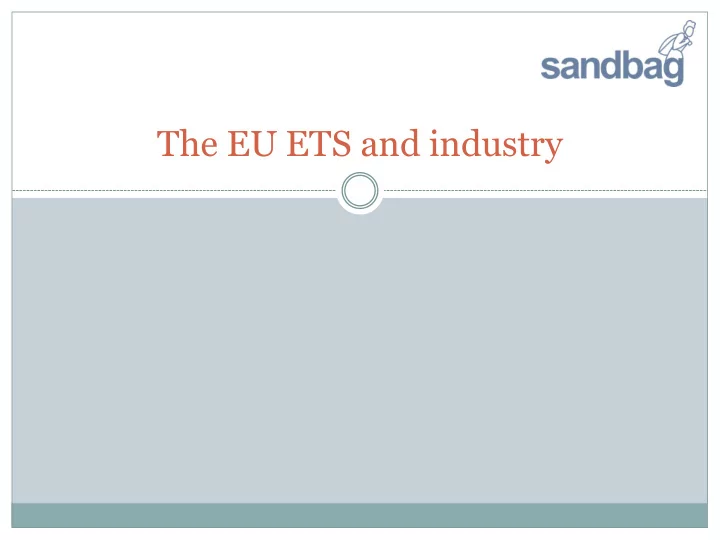

The EU ETS and industry
Is Europe pulling it’s weight on climate change? Conservatively estimated Europe has a 14% share of 2°C compatible carbon space available over 1990-2050 (based on its share of 1990 population). It used up around 67% of its budget barely a third of the way through the period. Even if the EU adopted a 30% climate target for 2020 and a 90% target for 2050 it would still exceed its carbon budget by around 30 billion tonnes over budget 65 1,701 168 104
EU has beaten its 2020 climate target 110% EU27 emissions adjusted for ETS offsets 105% 5,936 EU27 GHGs incl aviation excl LULUCF 1990 emissions baseline EU27 20% target for 2020 100% 5,653 Emissions (Mt) 95% 5,370 90% 5,088 85% 4,805 84% 80% 4,522 79% 75% 4,240 70% 3,957 1990 1991 1992 1993 1994 1995 1996 1997 1998 1999 2000 2001 2002 2003 2004 2005 2006 2007 2008 2009 2010 2011E
The new economic outlook
Change in “baseline” emissions forecasts since 2008 2,500 MtCO2e 2.2 Gt 2,000 1,500 1,000 500 - 2008 2009 2010 2011 2012 2013 2014 2015 2016 2017 2018 2019 2020 2008 GHG projections 2,210 2,205 2,199 2,193 2,185 2,173 2,157 2,135 2,116 2,082 2,068 2,054 2,043 2012 GHG projections 2,118 1,877 1,932 1,895 1,880 1,965 1,979 1,987 1,997 1,984 1,992 2,001 2,002
Implications out to 2020 The EU ETS is a fundamentally less effective policy carrying more than a year’s worth of allowances. The offset budget for the traded sector, is now completely disproportionate to the domestic abatement obliged under the cap. The resulting carbon price is too low to encourage even the cheapest forms of domestic abatement out to at least 2020 (unless we intervene).
Implications for Phase 2 (2008-2012) The drop in demand over Phase 2 will leave the Phase 2 caps “long” by around 800Mt. By all accounts this is a larger volume than any abatement the carbon price may have delivered over the Phase. This implies that Phase 2 of the EU ETS threatens to have a net negative environmental effect, cancelling out emissions reductions the recession and other climate polices delivered by banking them forward for future use.
Manufacturing sectors in Phase 2 Net position EU manufacturing sectors 800 MtCO 2 e 700 600 594 500 400 300 200 100 0 2008 2009 2010 2011 Surplus Industry emissions Free allocations
Manufacturing company surpluses in Phase 2 350 MtCO2e 300 123 250 200 150 Phase 2 Surplus * Phase 2 Emissions 222 35 41 11 100 17 17 13 20 18 93 50 89 80 71 50 11 50 38 38 20 0
Future costs? 9 Cementos Portland MtCO2e 8 7 17.2 6 5 Surplus EUAs 4 Emissions 3 2 Allocations 1 0 2008 2009 2010 2011 2012 2013 2014 2015 2016 2017 2018 2019 2020 35 MtCO2e Tata 30 42.2 -5.8 25 Surplus EUAs 20 Emissions 15 Free allocations 10 Free allocations and carryover 5 0 2008 2009 2010 2011 2012 2013 2014 2015 2016 2017 2018 2019 2020
Future costs have been radically reduced The ETS compliance costs for manufacturing sectors are a tiny fraction of what they were expected to be because: The market price of carbon is less than a third of the € 30 average expected Surplus Phase 2 allowances will largely buffer them from this cost. Many manufacturing sectors have received additional free allowances because they are defined as exposed to carbon leakage; however: This assessment was performed under an obsolete € 30 carbon price assumption It did not take the protections afforded by standard benchmarked allowances or Phase 2 surpluses into account It did not exclude countries with comparable carbon pricing schemes from the trade intensity calculation
Conditional carbon price protections for industry Until such a time as the cap is tightened to create the € 30 carbon price in the leakage assessment, many sectors are due to receive free Phase 3 allocations on false grounds. Manufacturers’ should stop obstructing cap reform if they expect their current free allocation privileges to be maintained AND/OR expect to receive full compensation for their indirect ETS costs. EU governments awarded industry billions of Euros in state assets to protect them from carbon leakage threats which never materialised in Phase 2. To prevent good money flowing after bad, past surpluses and the evolving carbon price should be taken into account when: the carbon leakage list is reviewed, and State Aid compensations for electricity intensive industries are considered.
General recommendations Backload allowances as a temporary measure to counteract a surge in supply and prepare the market for a follow up structural intervention. Cancel these allowances as part of a broader package of structural measures, that include adopting a 30% 2020 climate target, and protections against future economic shocks. Change the long term trajectory of the ETS, and establish an ambitious Phase 4 budget under an ambitious 2030 target.
To find out more… Visit our website at www.sandbag.org.uk Email me at damien@sandbag.org.uk
Recommend
More recommend